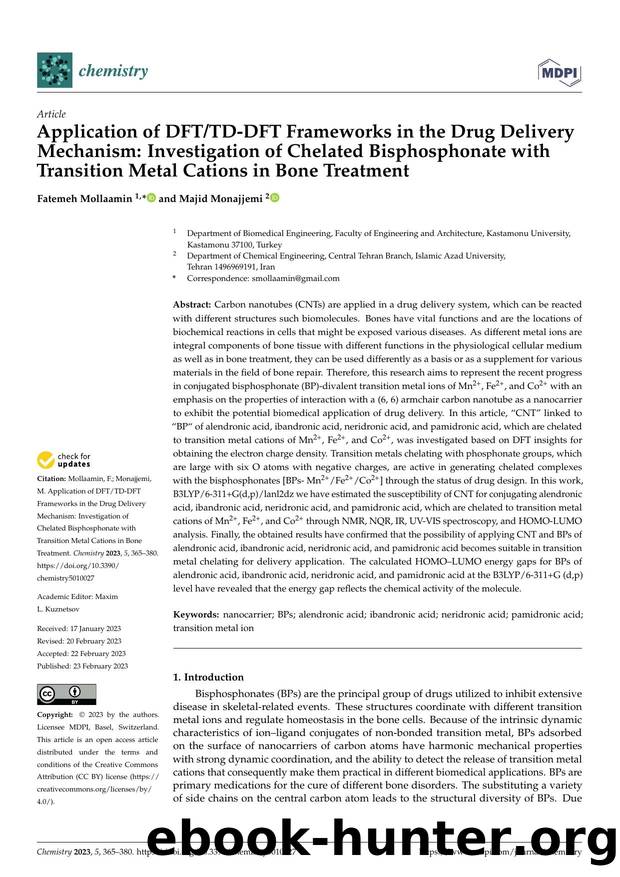Application of DFTTD-DFT Frameworks in the Drug Delivery Mechanism: Investigation of Chelated Bisphosphonate with Transition Metal Cations in Bone Treatment by Fatemeh Mollaamin & Majid Monajjemi

Author:Fatemeh Mollaamin & Majid Monajjemi
Format: pdf
Tags: Carbon nanotubes (CNTs) are applied in a drug delivery system, which can be reacted with different structures such biomolecules. Bones have vital functions and are the locations of biochemical reactions in cells that might be exposed various diseases. As different metal ions are integral components of bone tissue with different functions in the physiological cellular medium as well as in bone treatment, they can be used differently as a basis or as a supplement for various materials in the field of bone repair. Therefore, this research aims to represent the recent progress in conjugated bisphosphonate (BP)-divalent transition metal ions of Mn2+, Fe2+, and Co2+ with an emphasis on the properties of interaction with a (6, 6) armchair carbon nanotube as a nanocarrier to exhibit the potential biomedical application of drug delivery. In this article, “CNT” linked to “BP“ of alendronic acid, ibandronic acid, neridronic acid, and pamidronic acid, which are chelated to transition metal cations of Mn2+, Fe2+, and Co2+, was investigated based on DFT insights for obtaining the electron charge density. Transition metals chelating with phosphonate groups, which are large with six O atoms with negative charges, are active in generating chelated complexes with the bisphosphonates [BPs- Mn2+/Fe2+/Co2+] through the status of drug design. In this work, B3LYP/6-311+G(d,p)/lanl2dz we have estimated the susceptibility of CNT for conjugating alendronic acid, ibandronic acid, neridronic acid, and pamidronic acid, which are chelated to transition metal cations of Mn2+, Fe2+, and Co2+ through NMR, NQR, IR, UV-VIS spectroscopy, and HOMO-LUMO analysis. Finally, the obtained results have confirmed that the possibility of applying CNT and BPs of alendronic acid, ibandronic acid, neridronic acid, and pamidronic acid becomes suitable in transition metal chelating for delivery application. The calculated HOMO–LUMO energy gaps for BPs of alendronic acid, ibandronic acid, neridronic acid, and pamidronic acid at the B3LYP/6-311+G (d,p) level have revealed that the energy gap reflects the chemical activity of the molecule., nanocarrier; BPs; alendronic acid; ibandronic acid; neridronic acid; pamidronic acid; transition metal ion
Download
This site does not store any files on its server. We only index and link to content provided by other sites. Please contact the content providers to delete copyright contents if any and email us, we'll remove relevant links or contents immediately.
Alchemy and Alchemists by C. J. S. Thompson(3450)
The Elements by Theodore Gray(2998)
The Club by A.L. Brooks(2862)
How to Make Your Own Soap by Sally Hornsey(2827)
Drugs Unlimited by Mike Power(2545)
Wheels of Life by Anodea Judith(2098)
Cracking the LSAT, 2012 Edition by Princeton Review(1883)
Cracking the Sat French Subject Test, 2013-2014 Edition by The Princeton Review(1829)
Perfume by Jean-Claude Ellena(1782)
The Flavor Matrix by James Briscione(1775)
The Cosmic Machine: The Science That Runs Our Universe and the Story Behind It by Scott Bembenek(1726)
Quantitative and Pattern Recognition Analyses of Five Marker Compounds in Raphani Semen using High-Performance Liquid Chromatography by Unknown(1669)
MCAT Physics and Math Review by Princeton Review(1637)
1000 Multiple-Choice Questions in Organic Chemistry by Organic Chemistry Academy(1621)
The Thing Around Your Neck by Chimamanda Ngozi Adichie(1600)
Handbook of Modern Sensors by Jacob Fraden(1544)
Cracking the SAT Premium Edition with 6 Practice Tests, 2017 by Princeton Review(1539)
Synchrotron Light Sources and Free-Electron Lasers by Eberhard J. Jaeschke Shaukat Khan Jochen R. Schneider & Jerome B. Hastings(1524)
A is for Arsenic: The Poisons of Agatha Christie (Bloomsbury Sigma) by Kathryn Harkup(1507)
